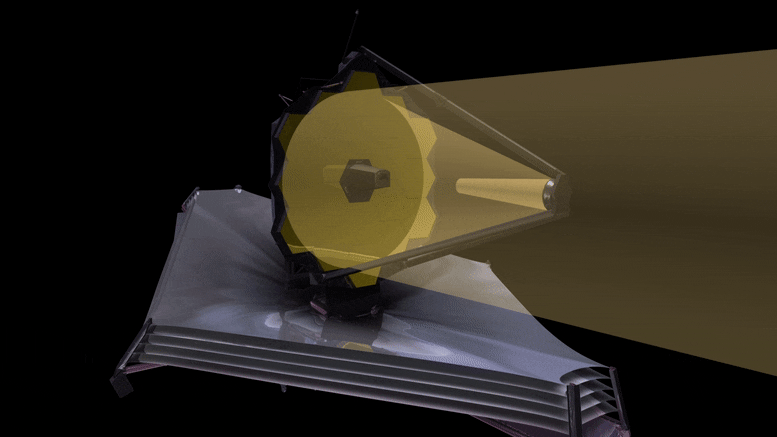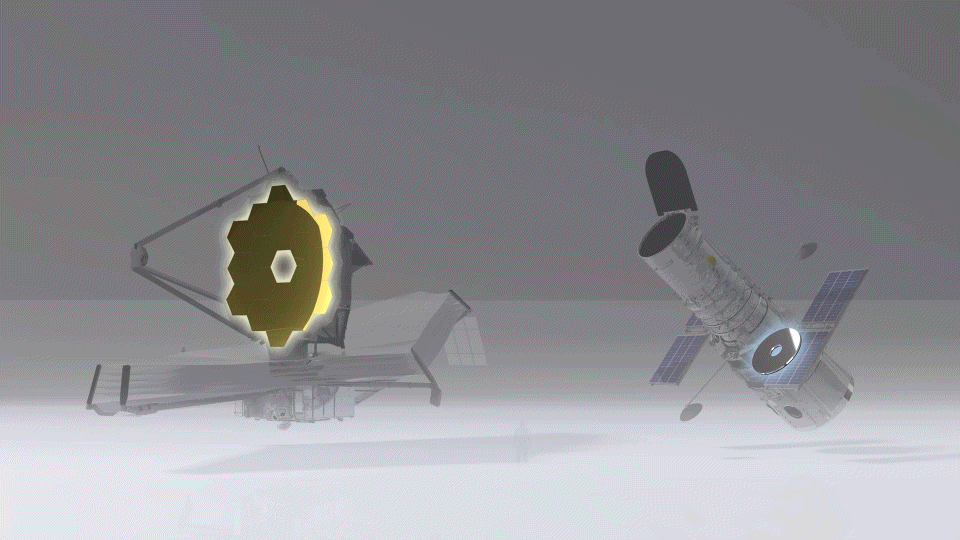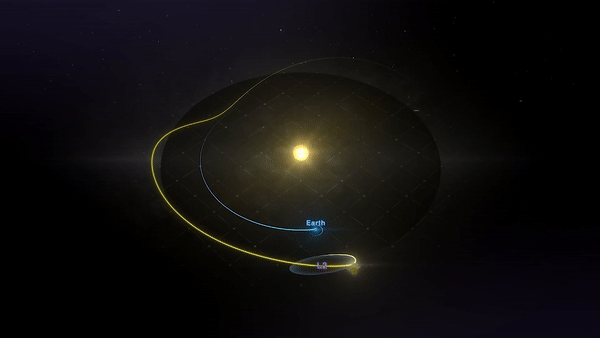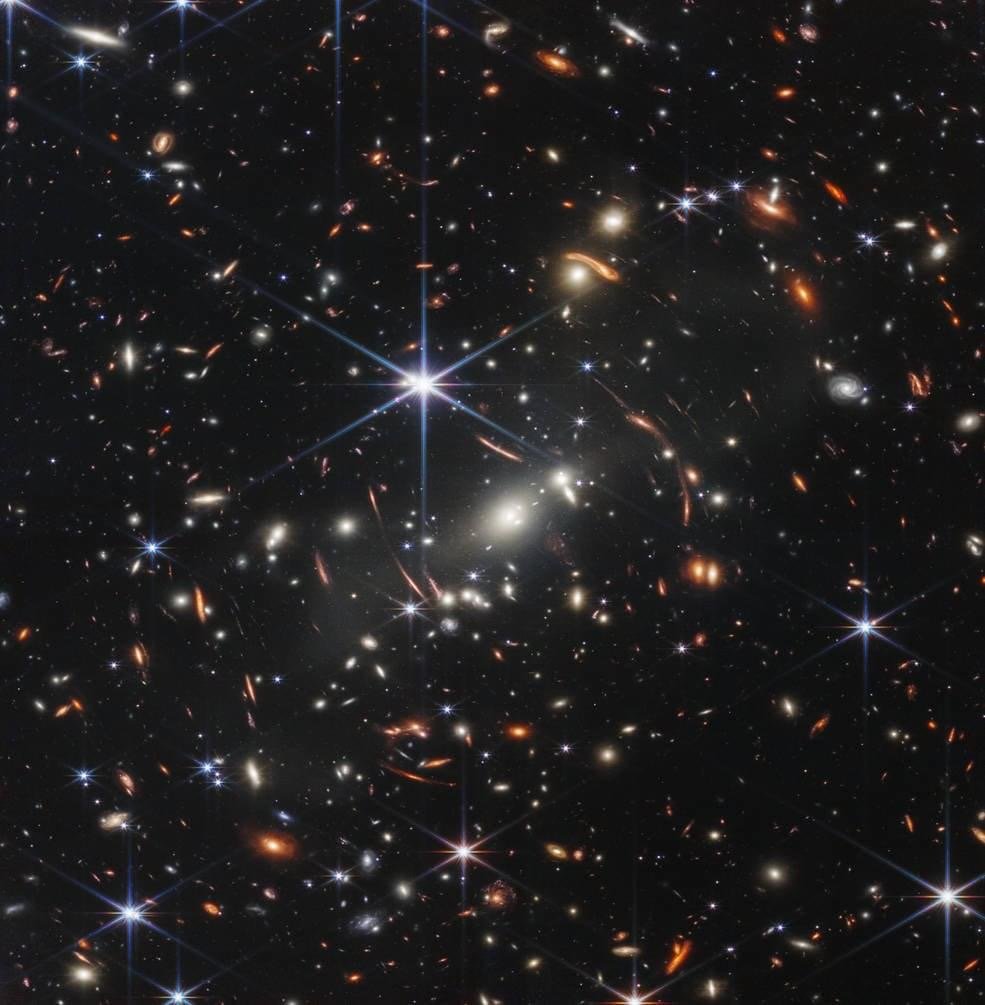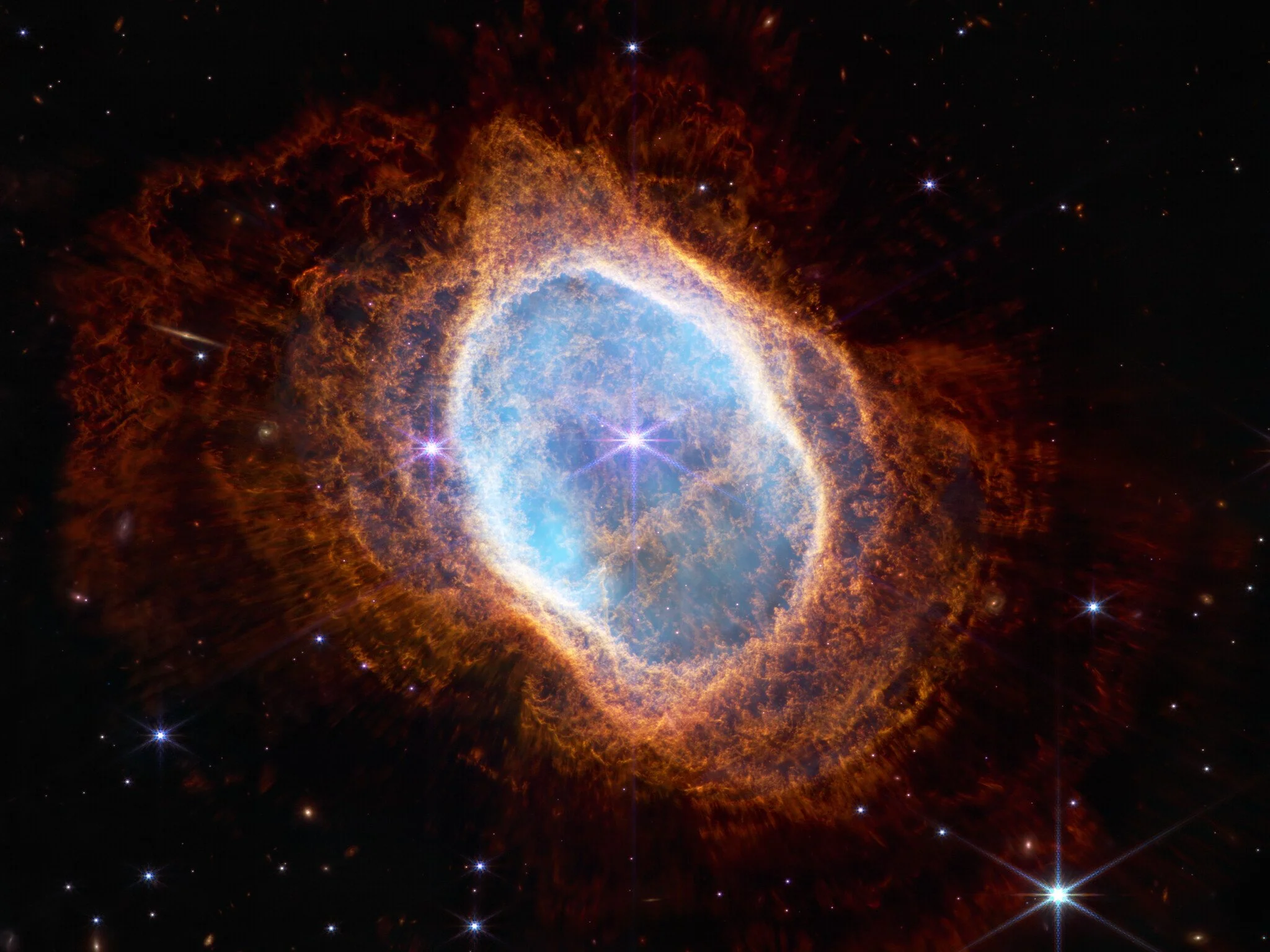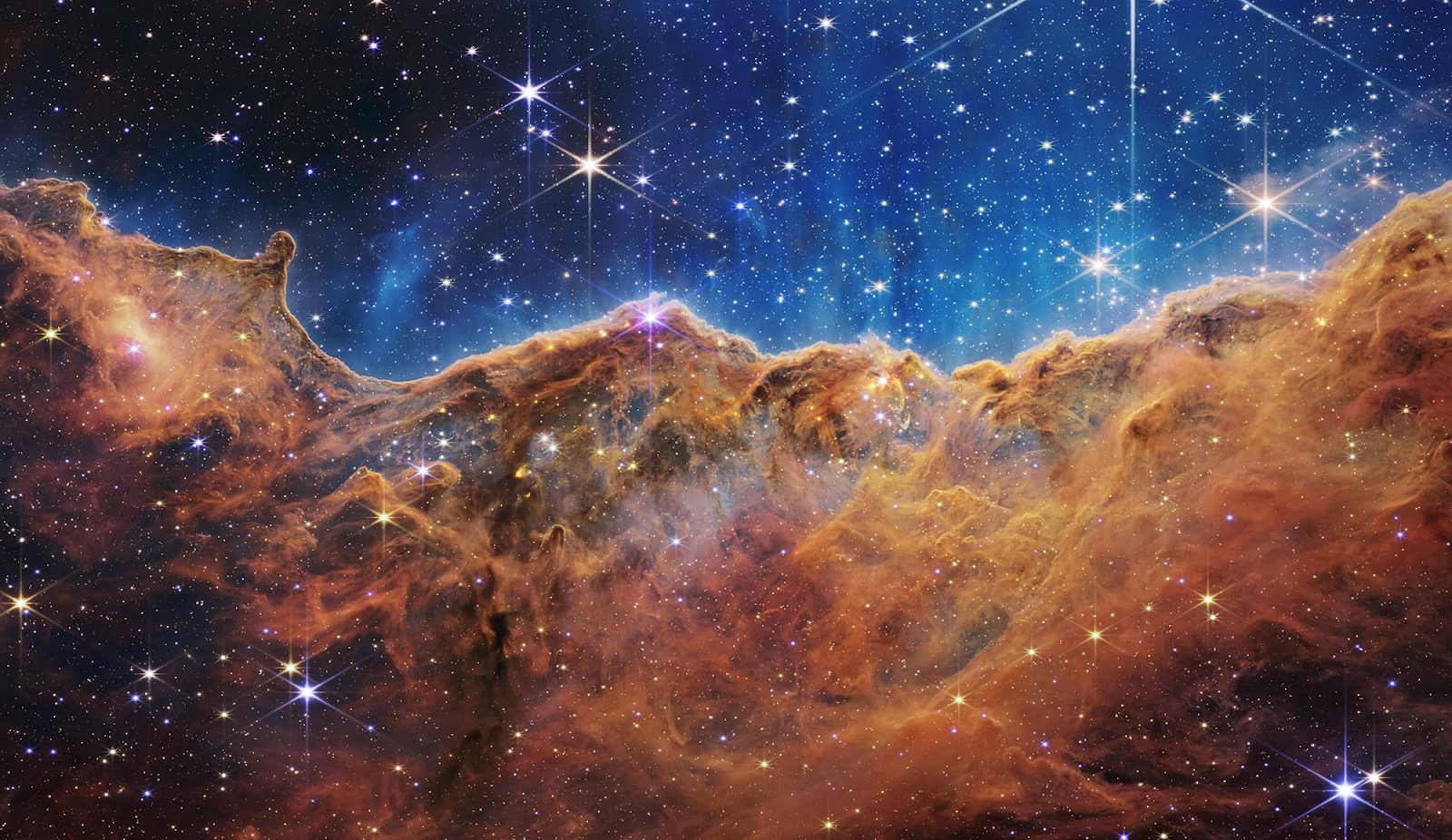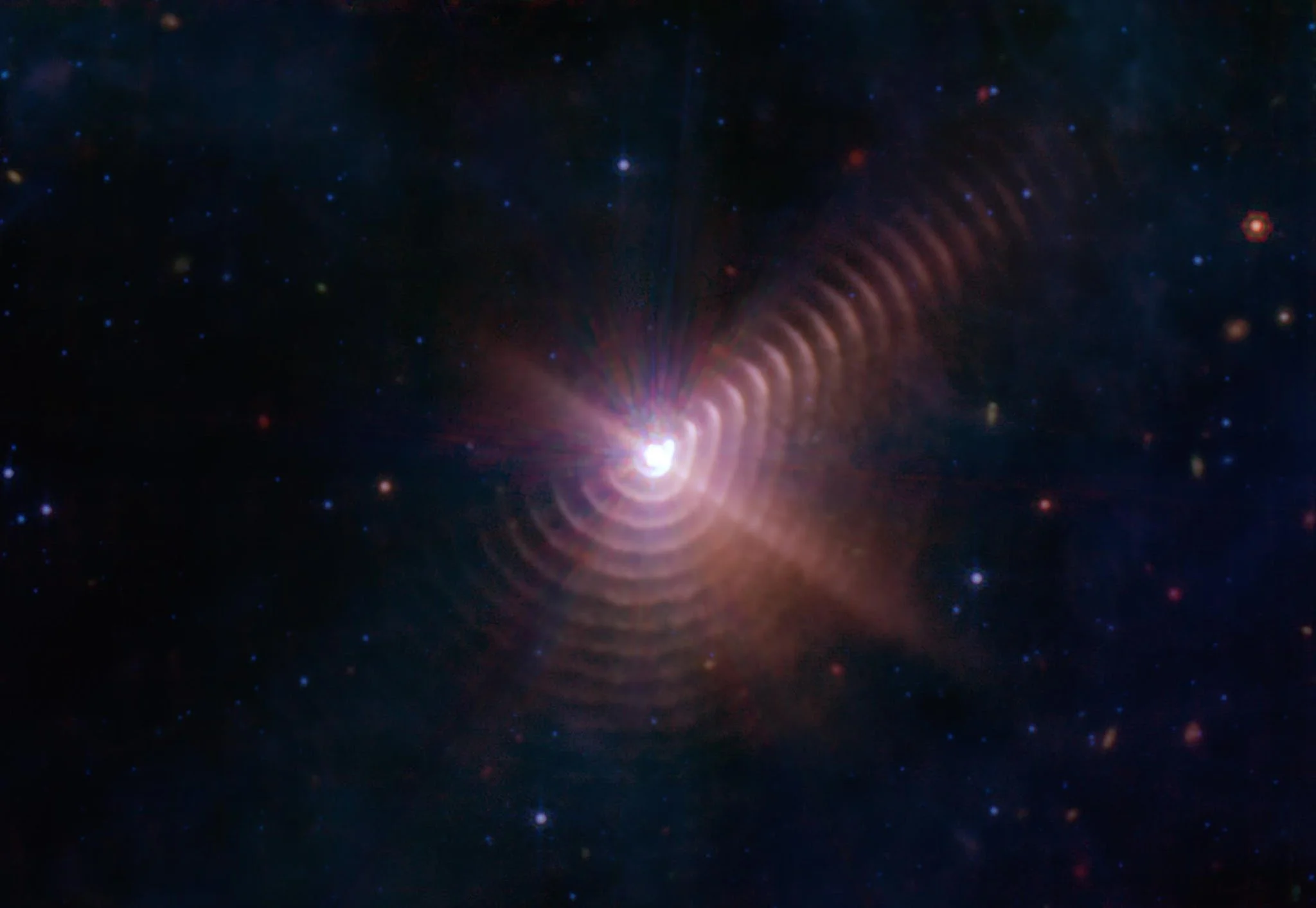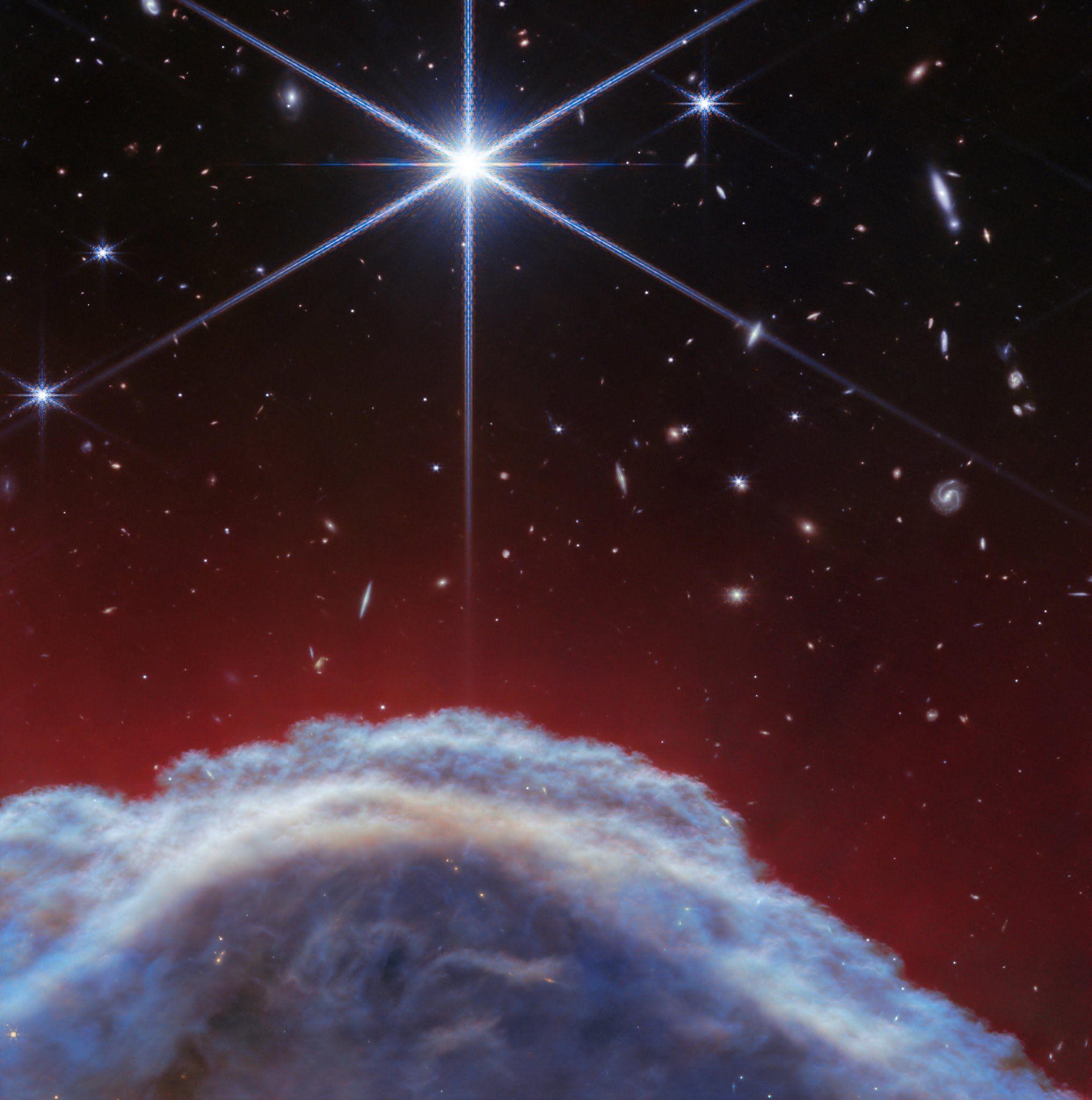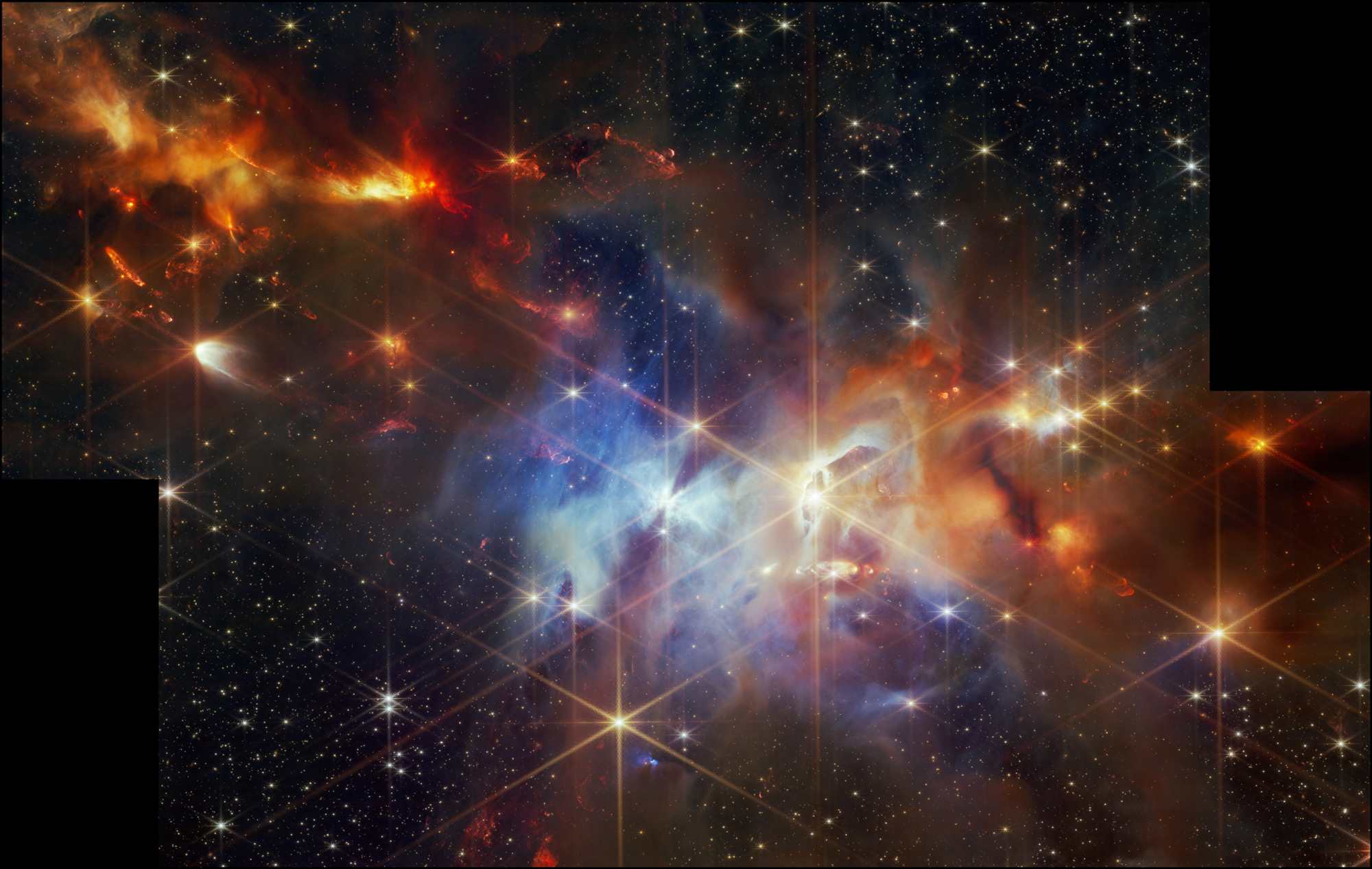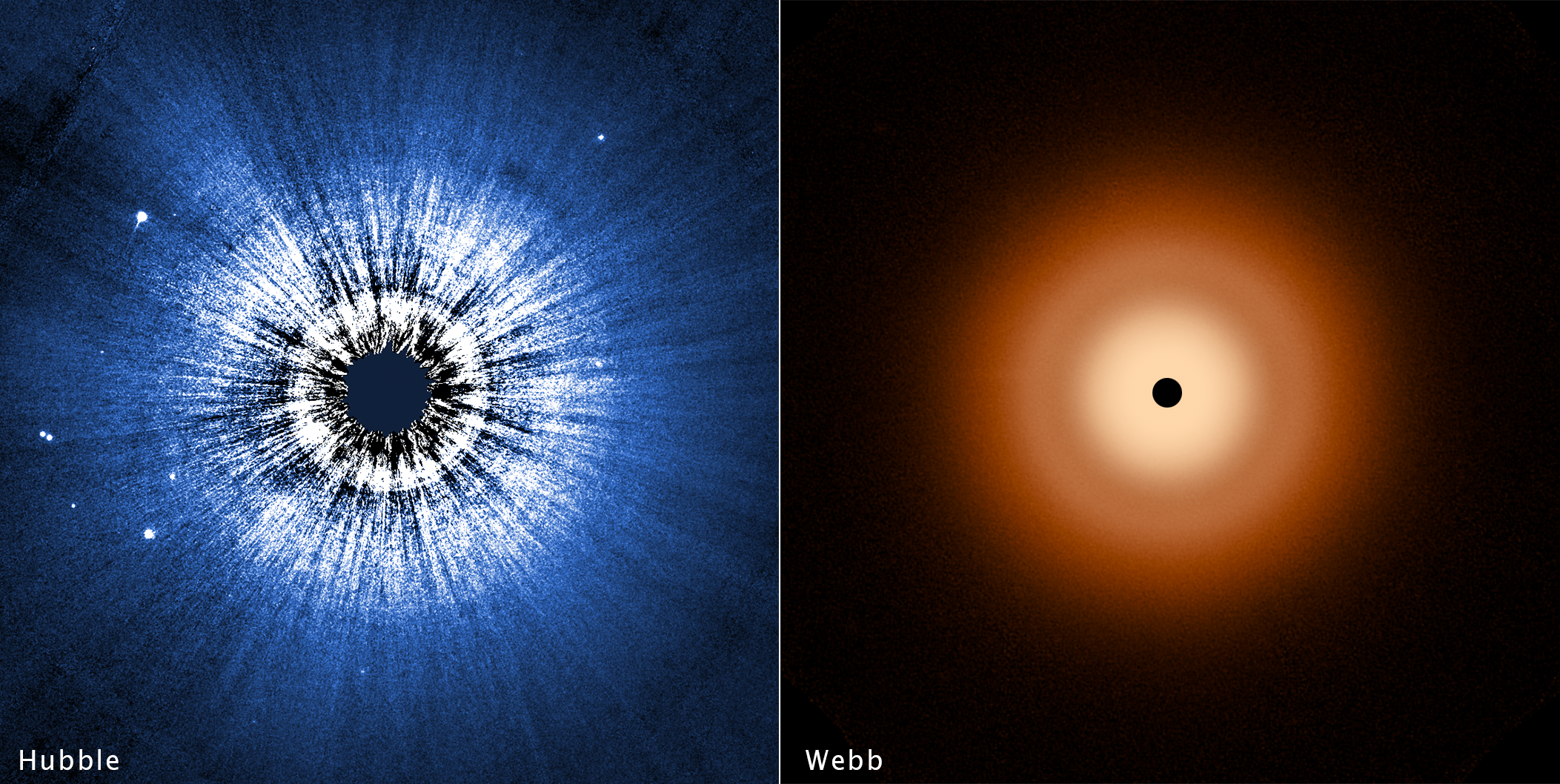The James Webb Space Telescope
by Sam Atkins
NOTE: Tap or hover over images for captions and credits.
The James Webb Space Telescope is the largest, most complex observatory sent into space. It was jointly developed by NASA, the European Space Agency, and the Canadian Space Agency. It is, in many ways, the next generation successor to the world-famous Hubble Space Telescope that still remains in operation today. Webb was launched on December 25, 2021 and the public began receiving images from it almost six months later. As of the publishing of this article, Webb has now been transmitting images back to Earth for three years.
Fun fact: The James Webb Space Telescope took ten years and $10 billion to develop and build. It was built at the Goddard Space Flight Center in Greenbelt, Maryland and is currently operated from the Space Telescope Science Institute at Johns Hopkins University in Baltimore, Maryland.
Though it is much, much larger and more advanced, Webb operates off the same basic principles as any reflector telescope you’d find in someone’s backyard. Being in space simply eliminates the distortions from Earth’s atmosphere.
Its concave primary mirror intercepts light traveling through space and reflects it forward into a smaller secondary mirror. The secondary mirror then directs the light into the scientific instruments where it is recorded. Those recordings are then transmitted via radio waves back to Earth where they are received, processed and analyzed by scientists. This is pretty much how the Hubble works too, so what’s the difference between them?
Bigger is better! Webb’s primary mirror is about six times bigger than Hubble’s. Having a larger mirror means being able to collect more light which allows Webb to see much further objects and with more resolution than we’ve ever seen before. Webb can see so far that it is expected to see galaxies that formed as far back as a quarter million years after the Big Bang.
Fun fact: Despite being several times larger than Hubble’s, Webb’s primary mirror is actually lighter in weight. It is made of beryllium, a metal which is very strong for its weight, good at holding its shape across a range of temperatures, a good conductor of electricity and heat, and is not magnetic.
Why is the primary mirror segmented into hexagons? James Webb Space Telescope’s primary mirror was simply too large to fit inside any currently existing rockets so it needed the ability to fold itself up into a more compact shape. Their honeycomb like arrangement allows for Webb to have the largest possible reflective surface area to make observations, with the least amount of dead space in between each. It also gives the primary mirror a roughly circular shape which can most effectively focus light into a compact point.
Fun fact: Each hexagon is equipped with a set of actuators that allow for impressively accurate fine-tuning of their position, angle, and even curvature.
Why gold? The answer to this is related to the other main difference between Webb and Hubble:
Another primary difference Webb has with Hubble is its focus on a different part of the light spectrum. Whereas Hubble’s main focus is on visible light (as well as a bit into infrared and ultraviolet), Webb’s focus is on the red to mid-infrared part of the spectrum. The thin layer of gold coating on Webb’s primary mirror reflects red and mid-infrared light extremely well.
Fun fact: Astronaut visors are also coated with gold to reflect the powerful solar radiation.
Infrared light has a longer wavelength and can pass through objects in space that visible light is blocked by, such as gas and dust. This is why images taken using telescopes which detect infrared frequencies can pick out objects beyond these clouds, and appear clearer than those taken using other telescopes. This will also allow Webb to focus on infrared-bright objects like extremely old and distant galaxies. This is expected to give us incredible new insight into how the early universe developed.
Because Webb is an infrared telescope, it needs to be kept as cool as possible, as heat sources like the Sun can interfere with its infrared viewing. Mounted under the primary mirror is a five-layered sunshield the size of a tennis court. It is made of a heat-resistant, strong material called Kapton, which is coated in aluminum and silicon.
Fun fact: Kapton is also used to make space blankets and tape. It was also used on the Apollo Lunar Module as thermal insulation.
In total, James Webb has four primary instruments for observation. These are like a Swiss Army knife that allow Webb to choose the right tool for the job as it focuses on a wide variety of cosmic objects. These range from high-resolution cameras, spectrographs which can break down light into its component wavelengths, coronagraphs which block the bright lights of stars to better see nearby objects like exoplanets and debris disks.
🔸Near-Infrared Camera (NIRCam)
🔸Near-Infrared Spectrograph (NIRSpec)
🔸Mid-Infrared Instrument (MIRI)
🔸Fine Guidance Sensors/Near-Infrared Imager and Slitless Spectrograph (FGS/NIRISS)
Webb is not in a low orbit around the Earth, like Hubble is. It is actually 1.5 million km away in orbit around the Sun in what is called the Sun-Earth Lagrange Point 2 (L2). Lagrange Points are various regions of space around any two massive celestial bodies in which their competing gravity finds an equilibrium and allows objects to natural find a stable orbit within. What’s special about the L2 orbit is that it lets Webb follow the Earth as it moves around the Sun, while keeping both the light and heat from both blocked by its large sunshield.
Images from Webb can be recognized by the six diffraction spikes that protrude from stars and other significantly bright objects. Diffraction spikes are patterns produced as light bends around the sharp edges of surfaces on a telescope. These six spikes correspond with Webb’s six-sided hexagonal primary mirror and its three-pronged strut that holds the secondary mirror.
What follows is a small but exceptional selection of the vistas and phenomena that Webb has brought to us during each year of operation. Each of the following images has the name of the target and the date of the image’s release.
WEBB’S FIRST YEAR
JAMES WEBB DEEP FIELD (SMACS 0723 GALAXY CLUSTER)
July 11, 2022
This iconic image was the first revealed to the public a day ahead of the official White House press event on July 12th, 2022. Demonstrating Webb’s power up front, this image represents a patch of sky the size of a grain of sand held at arms length. There are kind of three levels of depth on display here. In the foreground, we see a handful of nearby stars, each with six diffraction spikes. Beyond them is a distant galaxy cluster called SMACS 0723.
You’ll notice amongst this pool of galaxies there is a series of strange distortions. This is not a glitch. Those are actually there. These streaks are the light from background galaxies being warped as they pass through the extreme gravitational field of SMACS 0723 on its way to us. As described in Einstein’s general relativity, gravity distorts space and time. Objects with extreme gravity, distort space and time extremely. So much that it can actually bend, warp and magnify light passing within their proximity.
SOUTHERN RING NEBULA
July 12, 2022
Near-infrared
Mid-infrared
Another image revealed at the White House press event, this shows a planetary nebula in the southern constellation, Vela. These are giant shells of gas left behind by a dead low mass star, like our Sun. After the star sheds its outer layers, all that remains is the dense core in the form of a white dwarf.
In the first image, which was captured with Webb’s near-infrared imagery, you can see a central star with six diffraction spikes. To the lower left of that you can see the barely visible white dwarf (the source of the nebula) through one of the diffraction spikes. The white dwarf and this brighter, younger star nearby are locked into a tight orbit around each other. This is better revealed by Webb’s mid-infrared imager in the second image. The white dwarf appears red as longer wavelength colors more easily penetrate the gas and dust.
The surrounding bubble is seen in two primary layers, represented by different colors. The central region is significantly denser and glows with ionizing radiation from the blistering heat of the central stars. The outer region of the gaseous shell is thinner and cooler. A long time from now, this gas and dust will eventually coalesce via gravity to form a new generation of stars.
Note: On the left side of the images, through the nebula’s outer layer you can see a previously hidden galaxy edge-on, demonstrating again Webb’s infrared ability to see through hidden cosmic veils that visible light often can’t.
STEPHAN’S QUINTET
July 12, 2022
Another of the first images reveled at the White House press event in 2022, this shows the beautiful cosmic carnage of multi-galaxy collision. When galaxies get too close, the combined gravity of all their stars, gas and dust rip each other apart and create these distorted swirls. In Stephan’s Quintet we see five galaxies in the frame, though it should be noted that only four are actually interacting. The galaxy on the left is actually much nearer to us and only appears close to the others due to line-of-sight. As time goes on, the other four will warp around each other like cream in coffee until their combined gravity merges them together into one massive galaxy.
CARINA NEBULA’S “COSMIC CLIFF”
July 12, 2022
Still one of the most iconic images captured by Webb, this appropriately-nicknamed image appears as a mountainous cliffside of gas and dust. In reality, this is actually the periphery of a huge cavity in the larger Carina Nebula being eating away at by the blistering ultraviolet radiation of a cluster of hot, young stars just out of frame (to the north). If you look closely, you can see an ethereal glow emanating from the “cliffs” and the dust gradually burns away, growing the cavity more. In other instances, the intense radiation can trigger star formation deep within these gaseous regions.
Note: From left to right, this image represents about 16 light years of distance.
CARTWHEEL GALAXY
August 2, 2022
Another galactic collision but this one appears to be a hit-and-run. The large galaxy to the right is the Cartwheel Galaxy, named so for its ring-like structure. About 400 million years ago it is believed that the pink galaxy on the left smashed right the through the center of the Cartwheel Galaxy like a bullseye and continued on. The resulting shockwave rippled outward, causing the galaxy’s material shifting outward towards the periphery, forming a ring. Along the way, supersonic gas and dust slam into stationary gas and dust and the resulting heat triggers star formation. We can see the galaxy’s gravity starting to pull things back towards the center (the tendrils connecting the outer ring and inner core) while it continues to rotate. It may perhaps reform some version of its spiral structure one day.
PHANTOM GALAXY (M74)
August 29, 2022
The Phantom Galaxy (M74) is a spiral galaxy about 32 million light years away in the constellation Pisces. Because the disk is fully faced toward us, it is a popular target for profession astronomers to study the origin and structures of galactic spirals. It contains an estimated 100 billion stars. Here you can see two well-defined spiral arms wrapping around the core. Webb has used its infrared instruments to highlight and peer through M74’s dust lanes in search of hidden star-forming regions. These can be recognized as pink patches of light piercing through the dusty filaments of the spiral arms.
This is part of a collaborative international effort to chart 19 star-forming galaxies that also includes the Hubble and several ground-based observatories.
TARANTULA NEBULA
September 6, 2022
Webb spots a dense cluster of blue stars that have hollowed out a home within the gaseous Tarantula Nebula. This is located in the Large Megellanic Cloud, a satellite galaxy that orbits our Milky Way about 200,000 light years away. The Tarantula Nebula is one of the most active star forming regions in the known universe. That is well demonstrated in Webb’s image here which spans 340 light years across. The cavity at the center of the image has been burned away by the blistering ultraviolet radiation from the tens of thousands of young stars. The surrounding gas is illuminated by their intense glow with rust-colored gas representing cooler temperatures.
Note: Just above the cavity is a bubble within the gas being blown out by the stellar wind of interior stars.
WOLF-RAYET 140
October 12, 2022
This peculiar image may look like a digital glitch, but it captures a real and fascinating cosmic event. What you’re seeing is a binary pair of stars locked in an elliptical orbit, each tracing a stretched oval path that overlaps slightly, like an elongated Venn diagram. In this configuration, the stars swing close to each other every eight years before drifting apart again. With each close encounter, their powerful stellar winds collide, blasting out a shell of gas at incredible speeds. The 17 ring-like structures visible here are the remnants of those periodic encounters, marking each close pass over the centuries with stunning regularity.
EAGLE NEBULA’S “PILLARS OF CREATION”
October 19, 2022
One of the most iconic images in astronomy history is the Hubble’s 1995 photograph of the Pillars of Creation, a row of massive towers made of star-forming gas and dust at the heart of the Eagle Nebula. 27 years later, Webb captures this cosmic structure in unprecedented clarity and glamour. One of the most striking things is just how many more stars Webb is able to resolve in the image. At the fingertips of these various stellar peninsulas, you’ll find a misty glow of ionized hydrogen gas breaking free from the nebula. Inside the pillars you’ll see a crimson light of newborn stars piercing through their cocoons.
L1527 PROTOSTAR
November 16, 2022
Here, we see a brilliant light show from an infant star still in the midst of formation. Known as L1527, this protostar lies at the very center of the hourglass shape, obscured by a surrounding accretion disk of swirling dust falling into it. You can see this disk as a dark slit bisecting the neck of the hourglass. The star is only able to shine above and below which results in the hourglass shape as light shines through interstellar gas. You’ll notice the details in the gas which look like wisps and bubbles, which indicate sporadic stellar “burps” as the protostar ingests and expels material. The difference in color represents how thick the dust is with orange dust being thicker and blue dust being thinner. This image gives us a pretty good idea of what our own Sun would have looked like 5 billion years ago.
URANUS
April 6, 2023
Although Webb imaged each of the four outer giant planets of our solar system, I felt Uranus was the most striking of these. Not only do we get the planet and its shining rings but many of its moons. Together they shimmer like sapphire jewels against the darkness of the cosmos. This infrared view provides some interesting things to note. First, Uranus’ rings are often not very visible because they are very thin and dark compared to Saturn’s. Second, the northern hemisphere of Uranus is entering into its summer years as it faces directly towards the Sun because of its 98° tilt. You’ll notice this warms the gas and causes Webb’s infrared instrument to detect it as brighter. Also, despite the darkness of the background, Webb is still able to pick up numerous far away galaxies.
WEBB’S SECOND YEAR
RHO OPHIUCHI CLOUD COMPLEX
July 12, 2023
Webb celebrated the one-year anniversary of the release of its first images with this dazzling view of the closest star-forming region to Earth, the Rho Ophiuchus Cloud Complex. About 400 light years away, lying between Ophiuchus and Scorpius, hydrogen gas and dust swirl across interstellar space like paint on canvas. It’s a popular target for astronomers to study the birth and evolution of young stars. The most eye-catching part of the image is the central yellow gas which appears as a cavity shaped like an inverted cup. It is being carved out and illuminated by the radiation of the star in the lower center of the image, called S1. The various dark blobs of red that populate the top and right sides of the image are gaseous expulsions from infant stars. You can even see one of the protostars themselves at the top right nestled between to blobs.
HERBIG-HARO 46/47
July 26, 2023
This image shows a pair of actively-forming stars 1,470 light years away near the Gum Nebula. Here you can see them at the very center of the red diffraction spikes. The supersonic jets of gas and dust surrounding them are being repeatedly ingested and ejected by the infant stars themselves at their poles and give scientists a good idea of how much mass the stars are accruing as they evolve. The Sun must have looked very much like this in its own infancy.
A strange galaxy can be seen in the background that is curiously shaped like a question mark. Can you find it?
RING NEBULA (M57)
August 21, 2023
Found 2,500 light years away in the Lyra constellation, the Ring Nebula is one of the quintessential planetary nebulas, the lingering ghost of a dead star. When low-mass stars run out of fuel, they shed their outer layers which disperse out into these magnificent formations like a butterfly emerging from a cocoon. All that remains of the star is its dense core in the form of a white dwarf which continues to heat and ionize the gas around it.
In this image you can see a similar structure to what we found in the Southern Ring Nebula. The central region immediately surrounding the white dwarf is glowing in the scorching radiation of the stellar remnant. Beyond, in the yellow and red ring-like structure is a thick layer of cooler molecular hydrogen and carbon containing thousands of dense bubbles, called globules. Anyone the main ring are a series of wispy arcs of material. These are thought to be the result of interactions between the central star and a distant companion.
WHIRLPOOL GALAXY (M51)
August 29, 2023
The majestic spirals of the photogenic Whirlpool Galaxy are on full display within Webb’s infrared gaze. This structure of distinct arms is a great example of what’s known as a “grand design” spiral galaxy. Here, we can see the complex filaments of gas and dust interwoven through M51’s spiral arms in great detail. The dense yellow regions populating the winding arms represent bustling star-formation. The closer you get towards the center, the yellow regions flood the structure. The galactic core is a tight region of bright white and pale blue from the extremely dense older star where a supermassive black hole lurks deep within.
CRAB NEBULA (M1)
October 30, 2023
The Crab Nebula can be found 6,500 light years away in the Taurus constellation. It is famed as the first object deep sky object that is identified with a historically-observed supernova and the first object in Messier’s catalogue.
Webb captured this infrared image of the supernova remnant in incredible detail. It is dominated by filaments interconnected like complex web of ionized sulfur (orange), ionized iron (blue), dust (yellow and green). A newly discovered feature revealed by Webb is the pale, wispy medium that flows across the various cavities. This is called synchrotron radiation, the emission of electrons moving around magnetic fields at relativistic speeds (speeds so fast that time dilation is a significant factor in measuring them). The magnetic field is generated by the neutron star at the center of the nebula.
SAGITTARIUS C
November 20, 2023
At the very center of our Milky Way is a supermassive black hole named Sagittarius A* which everything in the galaxy revolves around. Just 300 light years away from Sgr A* is this large star-forming cloud named Sagittarius C. The cyan-colored haze at the center-left is ionized hydrogen gas. Scientists are still speculating about the needle like texture of the cloud. The cloud appears to wrap halfway around an orange clump of light which is a protostar cluster. The orange mass on the right of the image is a cloud of gas.
About 500,000 stars are featured in this image.
CASSIOPEIA A
December 10, 2023
This is the aftermath of a supernova. This is Cassiopeia A, a 10-light year wide supernova remnant which is found, naturally, in the Cassiopeia constellation at a distance of 11,000 light years. Created by a stellar explosion only 340 years old, Cas A is probably the youngest known supernova remnant in our galaxy.
Not all stars go supernova upon their death. That fate is reserved only for high mass stars. When they exhaust their fuel that sustains thermonuclear fusion in their core, these behemoths lose the outward force that keeps them from collapsing in on themself. When this happens, the energy from the collapse is so powerful that the explosion can be seen from far away galaxies. This image represents what remains of one of the most violent types of events found in the universe.
IC 348 BROWN DWARFS
December 13, 2024
Within this star cluster is the smallest free-floating brown dwarf ever discovered.
It is a common sentiment that Jupiter is a ‘failed star’ but it’s much more accurate to say that Jupiter is a really successful planet. It is brown dwarfs which bridge the divide between planets and stars. These are objects larger than the largest planets but smaller than the smallest main sequence stars. These are the true failed stars. They form in much the same way fully-fledged stars do, but fail to gain enough mass to trigger thermonuclear fusion in their cores, which is what really makes a star what it is.
The image is dominated by the wispy curtains of gas and dust that make up a reflection nebula, illuminated by the cluster of stars nestled within it. Towards the bottom of the image are a handful of unusually small brown dwarfs.
HORSE HEAD NEBULA
April 29, 2024
It’s too zoomed in for you to notice but this is the mane of the Horsehead Nebula which can be found near the end of Orion’s Belt. Traditional views of this nebula show a dark silhouette hiding all manner of things. However, with Webb’s infrared vision, it can see the scorching ultraviolet radiation of shrouded protostars piercing through the dusty veil in the bottom third of the image. You can also see a parade of diverse background galaxies peppered across the distant cosmos. Don’t mind the very distracting diffraction spikes photobombing the top third of the image. It is merely a foreground star that is much brighter (producing the exaggerated diffraction).
NGC 6440
May 1, 2024
Here we peer into the brilliantly dense center of a globular cluster, NGC 6440. It can be found 28,000 light years away in the Sagittarius constellation. This puts it somewhere in the galactic center of the Milky Way.
Hundreds of thousands to millions of very old white and yellow stars populate every part of the image, bound by their collective gravity into a tightly-packed sphere. If you look closely you can see that many of the stars each have diffraction spikes. Imagine the night sky on a planet around one of those stars!
SERPENS NEBULA
June 20, 2024
One of the prettier images taken by Webb in the second year, the Serpens Nebula appears here as like a fiery phoenix soaring across the cosmos. This is a very young and active star-forming region full of gas that is being fed to numerous protostars.
At the center of the image is a bright blue gaseous region and it is flanked by two regions of orange gas and red plumes that appear to be flowing away from it. This region is not glowing but is illuminated by the reflective light of nearby stars. If you look closely through out this complex of clouds, you can see Webb’s doing its thing. Embedded within the regions of dust and gas are infant protostars. You can identify them easily by their polar jet streams.
WEBB’S THIRD YEAR
ARP 142: PENGUIN & EGG
July 12, 2024
This image shows two merging galaxies known together as Arp 142. The swirling galaxy in the center is NGC 2936 but nicknamed the Penguin. Its structure is being torn apart by the gravitational force of the other galaxy. If you look where the penguin’s eye would be you can see a bright knot which is actually the central core of the galaxy. The spherical galaxy on the left is NGC 2937 but nicknamed the Egg. The Penguin is often said to look like it is closely guarding the egg from predators. These two galaxies are separated by 100,000 light years which is about the diameter of the Milky Way. They will eventually become one.
Note: At the top right we can see a blue spiral galaxy nearly edge-on hiding behind two stars. This is actually believed to be a small foreground object.
EPSILON INDI Ab
July 24, 2024
On the surface, this image probably doesn’t look particularly impressive to the average person but it is pretty awesome once you know what it is. This is a photograph of a planet. Not one in our solar system, but in another. The star Epsilon Indi is a relatively close 12 light years, which lies behind the center star symbol in this image. The star was intentionally blocked out with a coronagraph to prevent its blinding light from obscuring the objects around it. The orange light to the left of the image is the exoplanet Epsilon Indi Ab, a gas giant seven times the mass of Jupiter. As of 2025, this is the closest exoplanet to be directly imaged as well as the coolest (which is impressive considering Webb is an infrared telescope).
DIGEL CLOUD 2S
September 12, 2024
These luminous stars are all newborns, still expelling outflows of gas and dust. This dense star cluster lies on the extreme outskirts of the Milky Way galaxy (about 58,000 light years from the galactic center compared to our 27,000 light years). It is important to study stars in a variety of locations to see how their surrounding environments affect them and how to distinguish between those effects and unrelated ones.
To the top right of image is a sub-cluster of stars. Also, even through the red nebulous gas beyond, Webb can peer through to the faraway background galaxies.
IC 2163 & NGC 2207
October 31, 2024
Webb spots another cosmic collision between galaxies 114 million light years away in the Canis Major constellation. This pair is thought to have grazed each other millions of years ago and the combined gravity of their gas, dust and stars has pulled loose the threads of their structures. The smaller galaxy on the left appears to be passing behind the larger galaxy on the right. While it is surprisingly rare for actual stars to collide during these events due to the vast distances between them, it can trigger increased star formation when are gas and dust slammed into each other by the gravitational whirlwinds.
VEGA
November 1, 2024
One of the brightest stars in the night sky that dominates northern summers is Vega in the Lyra constellation. It is one of the closer stars to our solar system at just 25 light years away. Both Hubble and Webb have zeroed in on the dense debris disk surrounding the star. Hubble is looking at the visible reflected light while Webb is looking at direct infrared light.
As the disk has rotated around the star over millions of years, angular momentum has gradually pulled the disk into an organized structure of halos and gaps. The inner disk immediately around Vega is the thickest and spans 11 billion km out. The outer ring extends out to 24 billion km from Vega. A coronagraph was used to block out the excessive light from the star itself (shown as a black circle at the center).
SOMBRERO GALAXY (M104)
November 25, 2024
Another collaboration between Hubble and Webb, but this time they turn to a much, much bigger disk. This is the famous Sombrero Galaxy which lies between the constellations Virgo and Corvus. Seen edge on, the galaxy is most known for the dark halo of dust that wraps around the periphery. While Hubble’s view shows the galaxy much obscured by dust and the luminous central bulge, Webb shows a more razor sharp visage. A dark, smooth inner disk is surrounded by a bright, clumpy outer disk with substantial gap between them.
NGC 2566
December 18, 2024
76 million light years away in the southern constellation of Puppis is this peculiar figure oval-shaped spiral galaxy. The bright galactic core is very compact with faint strands of reddish dust flowing outward. They appear to reach out towards the two main spiral arms that join with the outer ring structure.
RETURN TO WOLF-RAYET 140
January 13, 2025
You may recall Webb looking at this fascinating object in an image released back in October 2022, during its first year of operation. The close interaction between binary stars has created a series of concentric shells of gas. This return look at this object shows how the spread of these rings have progressed over the previous fourteen months. In the bottom series of images you can see a comparison between the original look and the more recent one. In the third image of this row, the previous two images are overlayed so you can see how much the rings have moved. They are moving at about 1% the speed of light. That’s over 6.7 million miles per hour, fast enough to clear the distance between New York and Los Angeles in a single second!
FLAME NEBULA (NGC 2024)
March 10, 2025
Webb brought the Orion constellation’s striking Flame Nebula into focus. This nebula is not often very visible with simple telescopes but long exposure images reveal a complex structure.
On the left is a near-infrared image from Hubble. Here you can see the bright emission nebula which is made to glow by the ionizing radiation from nearby stars. This is contrasted by the dark gas and dust in the foreground, obscuring it.
The two infrared images on the right are from Webb, which zooms in on two particular star-forming regions within the Flame Nebula. Webb is able to peer through the thick dust and gas to see what lurks within. If you look close, you can see red points of light from infant stars and brown dwarfs.
HERBIG-HARO 49/50
March 24, 2025
This gorgeous Webb image shows a stellar jet, a far-reaching outflow of gas and dust ejected from a nearby infant star. These gaseous formations are known as Herbig-Haro objects. Think of it like the spreading wake left behind a speeding boat. The material moving at different speeds ends up slamming together, creating the bubbly appearance.
At the tip of this outflow is a chance meeting with a distant background galaxy that is oriented face-on to us. It has a bright central core surrounded by spiral arms, almost appearing like a ring.
NGC 1514
April 14, 2025
Webb’s mid-infrared image is the most detailed of this planetary nebula yet. This gaseous structure has spread out from a dying low mass star over 4,000 years. At center you can see the source of this nebula, a white dwarf with diffraction spikes. Its binary companion is seen just below it. Most strange are the two rings made of intricate filament of clumpy dust. Scientists say that prior to Webb, this ring structure was invisible to them. It is thought that they could have formed when the material spread out, became obstructed by the binary companion, forcing them outward into a bowl shape.
CAT’S PAW NEBULA
July 10, 2025
Webb celebrated three years of operation with this stunning image of the Cat’s Paw Nebula. This is located about 4,000 light years away in the summer constellation, Scorpius. This chaotic scene shows massive young stars carving out cavities in the surrounding gas and dust. Their powerful radiation illuminates the surrounding nebula in brilliant blue, creating the fun “toe beans” that inspired the region’s name.


